Deck 1: Introduction to Physiology
Question
Question
Question
Question
Question
Question
Question
Question
Question
Question
Question
Question
Question
Question
Question
Question
Question
Question
Question
Question
Question
Question
Question
Question
Question
Question
Question
Question
Question
Question
Question
Question
Question
Question
Question
Question
Question
Question
Question
Question
Question
Question
Question
Question
Question
Question
Question
Question
Question
Question
Question
Question
Question
Question
Question
Question
Question
Question
Question
Question
Question
Question
Question

Unlock Deck
Sign up to unlock the cards in this deck!
Unlock Deck
Unlock Deck
1/63
Play
Full screen (f)
Deck 1: Introduction to Physiology
1
Which of the following is a buffer zone between the outside world and most of the cells of the body?
A) blood
B) lumen
C) lymph
D) extracellular fluid
E) All of the answers are correct.
A) blood
B) lumen
C) lymph
D) extracellular fluid
E) All of the answers are correct.
D
2
"Glucose is transported from blood into cells because cells require glucose to meet their energy needs." This type of explanation is
A) mechanistic.
B) theological.
C) teleological.
D) metalogical.
E) scatological.
A) mechanistic.
B) theological.
C) teleological.
D) metalogical.
E) scatological.
C
3
A study in which a participant acts as an experimental subject in part of the experiment and a control in another part of the experiment is called what?
A) double-blind study
B) crossover study
C) meta-analysis study
D) retrospective study
A) double-blind study
B) crossover study
C) meta-analysis study
D) retrospective study
B
4
The Internet database for molecular,cellular,and physiological information is called the ________ Project.
A) Human Genome
B) Physiognomy
C) Physiosome
D) Physiome
E) Manhattan
A) Human Genome
B) Physiognomy
C) Physiosome
D) Physiome
E) Manhattan

Unlock Deck
Unlock for access to all 63 flashcards in this deck.
Unlock Deck
k this deck
5
If a scientific opinion has been verified repeatedly,it becomes a
A) model.
B) theory.
C) hypothesis.
D) law.
E) variable.
A) model.
B) theory.
C) hypothesis.
D) law.
E) variable.

Unlock Deck
Unlock for access to all 63 flashcards in this deck.
Unlock Deck
k this deck
6
The study of body function in a disease state is
A) necrology.
B) physiology.
C) microbiology.
D) pathophysiology.
E) histology.
A) necrology.
B) physiology.
C) microbiology.
D) pathophysiology.
E) histology.

Unlock Deck
Unlock for access to all 63 flashcards in this deck.
Unlock Deck
k this deck
7
Oxytocin is a hormone that is released in response to cervical dilation.It in turn causes more uterine contractions that will further dilate the cervix.What type of feedback loop does oxytocin trigger?
A) negative feedback
B) positive feedback
C) local control
D) nociceptive feedback
A) negative feedback
B) positive feedback
C) local control
D) nociceptive feedback

Unlock Deck
Unlock for access to all 63 flashcards in this deck.
Unlock Deck
k this deck
8
Because anatomy and physiology have different definitions,they are usually considered separately in studies of the body.

Unlock Deck
Unlock for access to all 63 flashcards in this deck.
Unlock Deck
k this deck
9
A technique used to resolve contradictory results in scientific studies is
A) meta-analysis.
B) retrospective analysis.
C) prospective analysis.
D) cross-sectional analysis.
E) longitudinal analysis.
A) meta-analysis.
B) retrospective analysis.
C) prospective analysis.
D) cross-sectional analysis.
E) longitudinal analysis.

Unlock Deck
Unlock for access to all 63 flashcards in this deck.
Unlock Deck
k this deck
10
Which of the following is one of Cannon's "internal secretions"?
A) hormones
B) nutrients
C) water
D) inorganic ions
E) None of the answers are correct.
A) hormones
B) nutrients
C) water
D) inorganic ions
E) None of the answers are correct.

Unlock Deck
Unlock for access to all 63 flashcards in this deck.
Unlock Deck
k this deck
11
Homeostasis is the ability of the body to
A) prevent the external environment from changing.
B) prevent the internal environment from changing.
C) quickly restore changed conditions to normal.
D) ignore external stimuli to remain in a state of rest.
E) prevent excessive blood loss.
A) prevent the external environment from changing.
B) prevent the internal environment from changing.
C) quickly restore changed conditions to normal.
D) ignore external stimuli to remain in a state of rest.
E) prevent excessive blood loss.

Unlock Deck
Unlock for access to all 63 flashcards in this deck.
Unlock Deck
k this deck
12
The literal meaning of the term physiology is knowledge of
A) organs.
B) nature.
C) science.
D) chemistry.
E) math.
A) organs.
B) nature.
C) science.
D) chemistry.
E) math.

Unlock Deck
Unlock for access to all 63 flashcards in this deck.
Unlock Deck
k this deck
13
The following is a list of several levels of organization that make up the human body.
1)tissue
2)cell
3)organ
4)molecule
5)organism
6)organ system
The correct order from the smallest to the largest is
A) 2, 4, 1, 3, 6, 5.
B) 4, 2, 1, 6, 3, 5.
C) 4, 2, 1, 3, 6, 5.
D) 4, 2, 3, 1, 6, 5.
E) 6, 4, 5, 2, 3, 1.
1)tissue
2)cell
3)organ
4)molecule
5)organism
6)organ system
The correct order from the smallest to the largest is
A) 2, 4, 1, 3, 6, 5.
B) 4, 2, 1, 6, 3, 5.
C) 4, 2, 1, 3, 6, 5.
D) 4, 2, 3, 1, 6, 5.
E) 6, 4, 5, 2, 3, 1.

Unlock Deck
Unlock for access to all 63 flashcards in this deck.
Unlock Deck
k this deck
14
A scientifically logical guess is a
A) model.
B) theory.
C) hypothesis.
D) law.
E) variable.
A) model.
B) theory.
C) hypothesis.
D) law.
E) variable.

Unlock Deck
Unlock for access to all 63 flashcards in this deck.
Unlock Deck
k this deck
15
Physiology is the study of
A) the structure of the body.
B) the tissues and organs of the body at the microscopic level.
C) growth and reproduction.
D) the normal functions of the organ systems.
E) the facial features as an indication of personality.
A) the structure of the body.
B) the tissues and organs of the body at the microscopic level.
C) growth and reproduction.
D) the normal functions of the organ systems.
E) the facial features as an indication of personality.

Unlock Deck
Unlock for access to all 63 flashcards in this deck.
Unlock Deck
k this deck
16
Place these terms in the typical sequence in which they appear in the scientific process: experimental data,theory,model,observation,hypothesis,replication.
A) experimental data, theory, model, observation, hypothesis, replication
B) replication, hypothesis, experimental data, theory, model, observation
C) theory, observation, experimental data, hypothesis, replication, model
D) observation, replication, model, experimental data, hypothesis, theory
E) observation, hypothesis, experimental data, replication, model, theory
A) experimental data, theory, model, observation, hypothesis, replication
B) replication, hypothesis, experimental data, theory, model, observation
C) theory, observation, experimental data, hypothesis, replication, model
D) observation, replication, model, experimental data, hypothesis, theory
E) observation, hypothesis, experimental data, replication, model, theory

Unlock Deck
Unlock for access to all 63 flashcards in this deck.
Unlock Deck
k this deck
17
A physician basing clinical decisions on primary research published in biomedical literature is doing ________ medicine.
A) evidence-based
B) traditional
C) alternative
D) whimsical
E) holistic
A) evidence-based
B) traditional
C) alternative
D) whimsical
E) holistic

Unlock Deck
Unlock for access to all 63 flashcards in this deck.
Unlock Deck
k this deck
18
A placebo is
A) any drug being tested in a clinical trial.
B) any drug in a class of drugs commonly used as pain relievers.
C) a drug or treatment that is expected to have no pharmacological effect.
D) a nutritive and respiratory organ in fetal development.
E) a hole in a cavity wall through which an organ protrudes.
A) any drug being tested in a clinical trial.
B) any drug in a class of drugs commonly used as pain relievers.
C) a drug or treatment that is expected to have no pharmacological effect.
D) a nutritive and respiratory organ in fetal development.
E) a hole in a cavity wall through which an organ protrudes.

Unlock Deck
Unlock for access to all 63 flashcards in this deck.
Unlock Deck
k this deck
19
How genetics influences the body's response to drugs is called
A) pharmacokinetics.
B) pharmacogenetics.
C) pharmacogenomics.
D) pharmacodynamics.
E) pharmageddon.
A) pharmacokinetics.
B) pharmacogenetics.
C) pharmacogenomics.
D) pharmacodynamics.
E) pharmageddon.

Unlock Deck
Unlock for access to all 63 flashcards in this deck.
Unlock Deck
k this deck
20
"Glucose is transported from blood into cells by transporters in response to insulin." This type of explanation is
A) mechanistic.
B) theological.
C) teleological.
D) metalogical.
E) scatological.
A) mechanistic.
B) theological.
C) teleological.
D) metalogical.
E) scatological.

Unlock Deck
Unlock for access to all 63 flashcards in this deck.
Unlock Deck
k this deck
21
You are interested in learning more about Parkinson's disease,a neurological disorder that primarily affects motor function.What is the best source to begin your investigation?
A) Google
B) PubMed
C) public library
D) physiology textbook
E) a physician
A) Google
B) PubMed
C) public library
D) physiology textbook
E) a physician

Unlock Deck
Unlock for access to all 63 flashcards in this deck.
Unlock Deck
k this deck
22
Seasonal Affective Depressive Disorder or SADD is a condition commonly seen in Northern climates of the United States and Canada and it may be due to a decrease in the amount of sunlight they receive during winter months.How is this condition related to biological rhythms and what process is not being compensated for well enough?

Unlock Deck
Unlock for access to all 63 flashcards in this deck.
Unlock Deck
k this deck
23
Why are physiology and anatomy frequently studied together?

Unlock Deck
Unlock for access to all 63 flashcards in this deck.
Unlock Deck
k this deck
24
Match the level of organization with its definition below.
A.a collection of similar cells that carry out similar functions
B.the smallest living unit
C.a collection of different tissues that carry out related functions
D.groups of organs functioning in a coordinated manner
cell
A.a collection of similar cells that carry out similar functions
B.the smallest living unit
C.a collection of different tissues that carry out related functions
D.groups of organs functioning in a coordinated manner
cell

Unlock Deck
Unlock for access to all 63 flashcards in this deck.
Unlock Deck
k this deck
25
Match the level of organization with its definition below.
A.a collection of similar cells that carry out similar functions
B.the smallest living unit
C.a collection of different tissues that carry out related functions
D.groups of organs functioning in a coordinated manner
tissue
A.a collection of similar cells that carry out similar functions
B.the smallest living unit
C.a collection of different tissues that carry out related functions
D.groups of organs functioning in a coordinated manner
tissue

Unlock Deck
Unlock for access to all 63 flashcards in this deck.
Unlock Deck
k this deck
26
Why is it necessary to label the axes of a graph?

Unlock Deck
Unlock for access to all 63 flashcards in this deck.
Unlock Deck
k this deck
27
Match the level of organization with its definition below.
A.a collection of similar cells that carry out similar functions
B.the smallest living unit
C.a collection of different tissues that carry out related functions
D.groups of organs functioning in a coordinated manner
organs
A.a collection of similar cells that carry out similar functions
B.the smallest living unit
C.a collection of different tissues that carry out related functions
D.groups of organs functioning in a coordinated manner
organs

Unlock Deck
Unlock for access to all 63 flashcards in this deck.
Unlock Deck
k this deck
28
A horse runs 10 races,each a mile long,during a 6-month period,and you are interested in determining if the horse's race time changes with experience.You set up a graph to display the race finish times of this horse. What type of graph would be best to display the race finish times of this horse?
A) bar graph
B) line graph
C) scatter plot
A) bar graph
B) line graph
C) scatter plot

Unlock Deck
Unlock for access to all 63 flashcards in this deck.
Unlock Deck
k this deck
29
You want to display data on the finish times of the 10 fastest race horses in a single race at the Kentucky Derby. What type of graph would be best to display this information?
A) bar graph
B) line graph
C) scatter plot
A) bar graph
B) line graph
C) scatter plot

Unlock Deck
Unlock for access to all 63 flashcards in this deck.
Unlock Deck
k this deck
30
What is a nocebo effect?

Unlock Deck
Unlock for access to all 63 flashcards in this deck.
Unlock Deck
k this deck
31
Match the level of organization with its definition below.
A.a collection of similar cells that carry out similar functions
B.the smallest living unit
C.a collection of different tissues that carry out related functions
D.groups of organs functioning in a coordinated manner
organ systems
A.a collection of similar cells that carry out similar functions
B.the smallest living unit
C.a collection of different tissues that carry out related functions
D.groups of organs functioning in a coordinated manner
organ systems

Unlock Deck
Unlock for access to all 63 flashcards in this deck.
Unlock Deck
k this deck
32
You conduct an experiment on twenty 18-year-old male subjects to see how various intensities of exercise influence heart rate.Which of the following is/are considered a dependent variable?
A) age of subjects
B) sex of subjects
C) intensity of exercise
D) heart rate
E) More than one of the answers is correct.
A) age of subjects
B) sex of subjects
C) intensity of exercise
D) heart rate
E) More than one of the answers is correct.

Unlock Deck
Unlock for access to all 63 flashcards in this deck.
Unlock Deck
k this deck
33
Adaptive significance is an important concept in physiology because it describes
A) the importance of a highly variable external environment.
B) the physiological functions that promote an organism's survival.
C) the ability of an organism to monitor and restore its internal state to normal conditions when necessary.
D) the similarities between ancient and modern marine organisms.
E) the parameters necessary to maintain a constant internal environment.
A) the importance of a highly variable external environment.
B) the physiological functions that promote an organism's survival.
C) the ability of an organism to monitor and restore its internal state to normal conditions when necessary.
D) the similarities between ancient and modern marine organisms.
E) the parameters necessary to maintain a constant internal environment.

Unlock Deck
Unlock for access to all 63 flashcards in this deck.
Unlock Deck
k this deck
34
What are the labels for the graph axes?

Unlock Deck
Unlock for access to all 63 flashcards in this deck.
Unlock Deck
k this deck
35
What would the labels be for the graph axes?

Unlock Deck
Unlock for access to all 63 flashcards in this deck.
Unlock Deck
k this deck
36
There are 10 cloned horses,born on the same day,with identical chromosomes.They are each subjected to the same physical training regimen,but given daily injections of different concentrations of a particular vitamin.They all run the same race.You set up a graph to explore a relationship between race finish time and vitamin dose. Which type of graph is best to explore a relationship between race finish time and vitamin dose?
A) bar graph
B) line graph
C) scatter plot
A) bar graph
B) line graph
C) scatter plot

Unlock Deck
Unlock for access to all 63 flashcards in this deck.
Unlock Deck
k this deck
37
What is the difference between a peer-reviewed article and a review article?

Unlock Deck
Unlock for access to all 63 flashcards in this deck.
Unlock Deck
k this deck
38
What is the major problem with the deconstructionist view of biology?

Unlock Deck
Unlock for access to all 63 flashcards in this deck.
Unlock Deck
k this deck
39
What would the labels be for the graph axes?

Unlock Deck
Unlock for access to all 63 flashcards in this deck.
Unlock Deck
k this deck
40
You conduct an experiment on twenty 18-year-old male subjects to see how various intensities of exercise influence heart rate.Which of the following is/are considered an independent variable?
A) age of subjects
B) sex of subjects
C) intensity of exercise
D) heart rate
E) More than one of the answers is correct.
A) age of subjects
B) sex of subjects
C) intensity of exercise
D) heart rate
E) More than one of the answers is correct.

Unlock Deck
Unlock for access to all 63 flashcards in this deck.
Unlock Deck
k this deck
41
What is a hypothesis? What are the steps involved in following the scientific method? How does one distinguish the dependent variable from the independent variable in an experiment? How are each of these represented on a graph?

Unlock Deck
Unlock for access to all 63 flashcards in this deck.
Unlock Deck
k this deck
42
Write a teleological explanation for why heart rate increases during exercise.Now write a mechanistic explanation for the same phenomenon.

Unlock Deck
Unlock for access to all 63 flashcards in this deck.
Unlock Deck
k this deck
43
Use the table and graph below to answer the following questions. 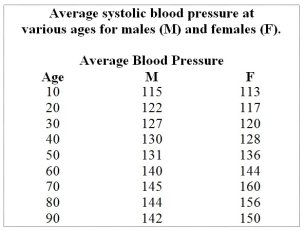 Table 1.2
Table 1.2 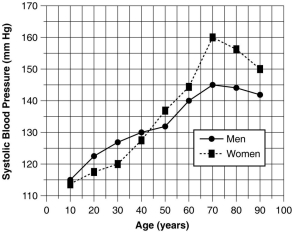 Figure 1.2
Figure 1.2
Summarize the data shown in Figure 1.2.
 Table 1.2
Table 1.2  Figure 1.2
Figure 1.2Summarize the data shown in Figure 1.2.

Unlock Deck
Unlock for access to all 63 flashcards in this deck.
Unlock Deck
k this deck
44
Use the table and graph below to answer the following questions. 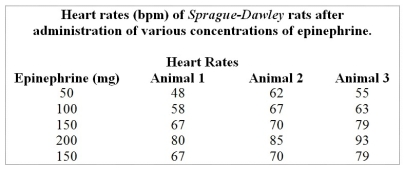 Table 1.1
Table 1.1 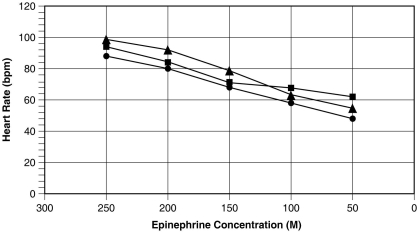 Figure 1.1
Figure 1.1
Use Table 1.1 to graph the data appropriately.What can you CONCLUDE based on the new figure?
 Table 1.1
Table 1.1  Figure 1.1
Figure 1.1Use Table 1.1 to graph the data appropriately.What can you CONCLUDE based on the new figure?

Unlock Deck
Unlock for access to all 63 flashcards in this deck.
Unlock Deck
k this deck
45
You conduct an experiment on twenty 18-year-old male subjects to see how various levels of exercise influence heart rate.Explain why only 18-year-old males were used as subjects.

Unlock Deck
Unlock for access to all 63 flashcards in this deck.
Unlock Deck
k this deck
46
You are doing an experiment to determine if caffeine consumption affects reaction time.
A.Which is the dependent variable?
B.Which is the independent variable?
C.Briefly describe some ways you might manipulate the independent variable.
D.Name three stimuli you could use,and how you might measure reaction time for each.
E.Write an appropriate hypothesis for this study.
F.You compute the following average values from your experiment.What would be a logical conclusion for these data?
Average caffeine consumer's reaction time: 400 ms
Average noncaffeine consumer's reaction time: 650 ms
G.Sketch a simple graph to convey these results to your classmates.What kind of graph did you choose? Why? Which variable did you plot on the x-axis? Which one did you plot on the y-axis? Why?
H.Do the results of this experiment support the hypothesis you chose?
A.Which is the dependent variable?
B.Which is the independent variable?
C.Briefly describe some ways you might manipulate the independent variable.
D.Name three stimuli you could use,and how you might measure reaction time for each.
E.Write an appropriate hypothesis for this study.
F.You compute the following average values from your experiment.What would be a logical conclusion for these data?
Average caffeine consumer's reaction time: 400 ms
Average noncaffeine consumer's reaction time: 650 ms
G.Sketch a simple graph to convey these results to your classmates.What kind of graph did you choose? Why? Which variable did you plot on the x-axis? Which one did you plot on the y-axis? Why?
H.Do the results of this experiment support the hypothesis you chose?

Unlock Deck
Unlock for access to all 63 flashcards in this deck.
Unlock Deck
k this deck
47
Following is a table of data collected from one section of an 8 a.m.physiology lab.There were 20 students present,10 men and 10 women.Information collected from the students included their height,weight,age,and resting pulse rate.In addition,the students were surveyed to see if they smoked cigarettes,considered themselves "regular exercisers," if they had consumed caffeine the morning of the lab,and if they had eaten breakfast that day.A "y" or "n" (yes or no)was recorded to indicate their answers.Each student did "jumping jacks" for 5 minutes and recorded the time required to regain their resting heart rate,which is listed on the table as "recovery time." Finally,each student participated in an exercise designed to measure their reaction time (in milliseconds)in catching an object dropped by a lab partner according to specified criteria.Use this table to answer the following questions.Ignore statistical problems caused by small sample size,and so on. 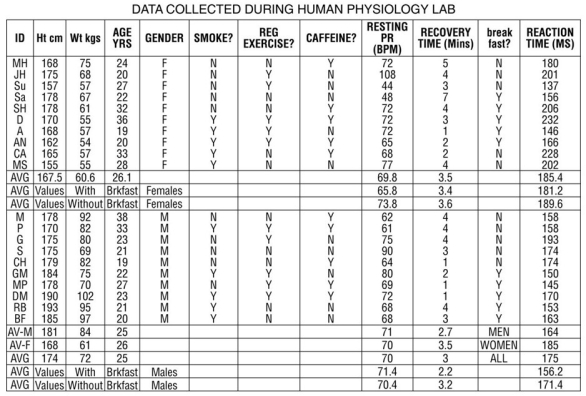 Table 1.3
Table 1.3 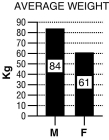 For these questions,the data were separated and analyzed by gender.
For these questions,the data were separated and analyzed by gender.
Refer to Table 1.3 and the bar graph.
A.Write a hypothesis regarding gender and recovery time.
B.What is the dependent variable? What is the independent variable?
C.Create a graph using the averages from the data table.Based on these data,what do you conclude?
 Table 1.3
Table 1.3  For these questions,the data were separated and analyzed by gender.
For these questions,the data were separated and analyzed by gender.Refer to Table 1.3 and the bar graph.
A.Write a hypothesis regarding gender and recovery time.
B.What is the dependent variable? What is the independent variable?
C.Create a graph using the averages from the data table.Based on these data,what do you conclude?

Unlock Deck
Unlock for access to all 63 flashcards in this deck.
Unlock Deck
k this deck
48
Why is it necessary to space grid marks on a graph proportionally to the quantity measured (example: each square represents one centimeter)?

Unlock Deck
Unlock for access to all 63 flashcards in this deck.
Unlock Deck
k this deck
49
Use the table and graph below to answer the following questions.  Table 1.2
Table 1.2  Figure 1.2
Figure 1.2
Referring to Figure 1.2,at approximately what age do men begin to show higher systolic blood pressures than women? At what age does this trend reverse?
 Table 1.2
Table 1.2  Figure 1.2
Figure 1.2Referring to Figure 1.2,at approximately what age do men begin to show higher systolic blood pressures than women? At what age does this trend reverse?

Unlock Deck
Unlock for access to all 63 flashcards in this deck.
Unlock Deck
k this deck
50
You are designing a study to assess the effects of a new treatment for hypertension.What ethical considerations would you employ when monitoring your progress?

Unlock Deck
Unlock for access to all 63 flashcards in this deck.
Unlock Deck
k this deck
51
Provide an example of a control system.Be sure to include the three main components: an input signal,a controller,and an output signal.

Unlock Deck
Unlock for access to all 63 flashcards in this deck.
Unlock Deck
k this deck
52
Use the table and graph below to answer the following questions.  Table 1.2
Table 1.2  Figure 1.2
Figure 1.2
Referring to Table
1.2,what general trend in systolic blood pressures is seen as both men and women increase in age?
 Table 1.2
Table 1.2  Figure 1.2
Figure 1.2Referring to Table
1.2,what general trend in systolic blood pressures is seen as both men and women increase in age?

Unlock Deck
Unlock for access to all 63 flashcards in this deck.
Unlock Deck
k this deck
53
Use the table and graph below to answer the following questions.  Table 1.1
Table 1.1  Figure 1.1
Figure 1.1
List all of the errors in Figure 1.1.
 Table 1.1
Table 1.1  Figure 1.1
Figure 1.1List all of the errors in Figure 1.1.

Unlock Deck
Unlock for access to all 63 flashcards in this deck.
Unlock Deck
k this deck
54
In your study of a drug's efficacy in treating hypertension,your subjects are white males,ages 40 to 60 years.Is your study applicable to all people? Explain.

Unlock Deck
Unlock for access to all 63 flashcards in this deck.
Unlock Deck
k this deck
55
Following is a table of data collected from one section of an 8 a.m.physiology lab.There were 20 students present,10 men and 10 women.Information collected from the students included their height,weight,age,and resting pulse rate.In addition,the students were surveyed to see if they smoked cigarettes,considered themselves "regular exercisers," if they had consumed caffeine the morning of the lab,and if they had eaten breakfast that day.A "y" or "n" (yes or no)was recorded to indicate their answers.Each student did "jumping jacks" for 5 minutes and recorded the time required to regain their resting heart rate,which is listed on the table as "recovery time." Finally,each student participated in an exercise designed to measure their reaction time (in milliseconds)in catching an object dropped by a lab partner according to specified criteria.Use this table to answer the following questions.Ignore statistical problems caused by small sample size,and so on.  Table 1.3
Table 1.3  For these questions,the data were separated and analyzed by gender.
For these questions,the data were separated and analyzed by gender.
Refer to Table 1.3 and the bar graph.
A.Write a hypothesis regarding gender and weight.
B.What is the dependent variable? What is the independent variable?
C.Based on the data in the graph above,what is your conclusion?
D.Why is a bar graph a good choice for presentation of these data? Would another type of chart be as effective?
 Table 1.3
Table 1.3  For these questions,the data were separated and analyzed by gender.
For these questions,the data were separated and analyzed by gender.Refer to Table 1.3 and the bar graph.
A.Write a hypothesis regarding gender and weight.
B.What is the dependent variable? What is the independent variable?
C.Based on the data in the graph above,what is your conclusion?
D.Why is a bar graph a good choice for presentation of these data? Would another type of chart be as effective?

Unlock Deck
Unlock for access to all 63 flashcards in this deck.
Unlock Deck
k this deck
56
High cholesterol levels have been known to be a contributing factor to heart disease and death due to cardiovascular disease for many decades.In the 1970's,scientists used this information to develop a hypothesis that giving a medicine to reduce blood cholesterol levels could reduce the chances of developing cardiovascular disease or dying from cardiovascular disease.They tested a group of people living in a town called Framingham,Massachusetts.This study became known as the Framingham Study and it is very well known,because it did not support the hypothesis that giving cholesterol lowering medications would reduce the risk of developing or dying from cardiovascular disease.Does this mean that high cholesterol is not a risk factor for heart disease? What does this demonstrate about the scientific process,especially as it pertains to human studies? You can find a copy of the study online and read it,if necessary.

Unlock Deck
Unlock for access to all 63 flashcards in this deck.
Unlock Deck
k this deck
57
Use the table and graph below to answer the following questions.  Table 1.1
Table 1.1  Figure 1.1
Figure 1.1
How can you determine the control value using Figure 1.1?
 Table 1.1
Table 1.1  Figure 1.1
Figure 1.1How can you determine the control value using Figure 1.1?

Unlock Deck
Unlock for access to all 63 flashcards in this deck.
Unlock Deck
k this deck
58
Design a concept map on scientific experimental design.

Unlock Deck
Unlock for access to all 63 flashcards in this deck.
Unlock Deck
k this deck
59
Explain why animals are used in research.Are there any limitations to the application of animal data to human physiology? Could these limitations be addressed using cell or tissue culture,or computer simulations?

Unlock Deck
Unlock for access to all 63 flashcards in this deck.
Unlock Deck
k this deck
60
Explain why the prefix homeo- is used in the term homeostasis.Why do some physiologists prefer the term homeodynamics over homeostasis?

Unlock Deck
Unlock for access to all 63 flashcards in this deck.
Unlock Deck
k this deck
61
Table
1.3 shows data on various factors that may or may not be related to resting pulse rate,time to recovery to resting pulse rate after a few minutes of exercise,and reaction time measured by how quickly a student could press a keyboard key after seeing a computer-generated prompt.For each question below,write a testable hypothesis,identify the dependent and independent variables,sketch an appropriate graph of the results,and draw a conclusion from the data presented in the table.Discuss your results.
A.Does caffeine consumption have an effect on resting pulse rate?
B.Does age play a role in resting pulse rate? Does weight?
C.Is there a relationship between eating breakfast and recovery time?
D.Is there a relationship between reaction time and height?
E.Do women who smoke show differences in their resting pulse rates compared to female nonsmokers or to male smokers and nonsmokers?
F.Does regular exercise have an effect on resting pulse rate?
1.3 shows data on various factors that may or may not be related to resting pulse rate,time to recovery to resting pulse rate after a few minutes of exercise,and reaction time measured by how quickly a student could press a keyboard key after seeing a computer-generated prompt.For each question below,write a testable hypothesis,identify the dependent and independent variables,sketch an appropriate graph of the results,and draw a conclusion from the data presented in the table.Discuss your results.
A.Does caffeine consumption have an effect on resting pulse rate?
B.Does age play a role in resting pulse rate? Does weight?
C.Is there a relationship between eating breakfast and recovery time?
D.Is there a relationship between reaction time and height?
E.Do women who smoke show differences in their resting pulse rates compared to female nonsmokers or to male smokers and nonsmokers?
F.Does regular exercise have an effect on resting pulse rate?

Unlock Deck
Unlock for access to all 63 flashcards in this deck.
Unlock Deck
k this deck
62
Following is a table of data collected from one section of an 8 a.m.physiology lab.There were 20 students present,10 men and 10 women.Information collected from the students included their height,weight,age,and resting pulse rate.In addition,the students were surveyed to see if they smoked cigarettes,considered themselves "regular exercisers," if they had consumed caffeine the morning of the lab,and if they had eaten breakfast that day.A "y" or "n" (yes or no)was recorded to indicate their answers.Each student did "jumping jacks" for 5 minutes and recorded the time required to regain their resting heart rate,which is listed on the table as "recovery time." Finally,each student participated in an exercise designed to measure their reaction time (in milliseconds)in catching an object dropped by a lab partner according to specified criteria.Use this table to answer the following questions.Ignore statistical problems caused by small sample size,and so on.  Table 1.3
Table 1.3  For these questions,the data were separated and analyzed by gender.
For these questions,the data were separated and analyzed by gender.
Refer to Table 1.3 and the bar graph.
A.Disregarding gender,write a hypothesis that expresses the relationship between weight and height.
B.What is the dependent variable? What is the independent variable?
C.From the data in Table
1.3,construct a graph that examines this relationship.
 Table 1.3
Table 1.3  For these questions,the data were separated and analyzed by gender.
For these questions,the data were separated and analyzed by gender.Refer to Table 1.3 and the bar graph.
A.Disregarding gender,write a hypothesis that expresses the relationship between weight and height.
B.What is the dependent variable? What is the independent variable?
C.From the data in Table
1.3,construct a graph that examines this relationship.

Unlock Deck
Unlock for access to all 63 flashcards in this deck.
Unlock Deck
k this deck
63
Following is a table of data collected from one section of an 8 a.m.physiology lab.There were 20 students present,10 men and 10 women.Information collected from the students included their height,weight,age,and resting pulse rate.In addition,the students were surveyed to see if they smoked cigarettes,considered themselves "regular exercisers," if they had consumed caffeine the morning of the lab,and if they had eaten breakfast that day.A "y" or "n" (yes or no)was recorded to indicate their answers.Each student did "jumping jacks" for 5 minutes and recorded the time required to regain their resting heart rate,which is listed on the table as "recovery time." Finally,each student participated in an exercise designed to measure their reaction time (in milliseconds)in catching an object dropped by a lab partner according to specified criteria.Use this table to answer the following questions.Ignore statistical problems caused by small sample size,and so on.  Table 1.3
Table 1.3  For these questions,the data were separated and analyzed by gender.
For these questions,the data were separated and analyzed by gender.
Refer to Table 1.3 and the bar graph.
A.Write a hypothesis regarding the effects of breakfast consumption on reaction time.
B.What is the dependent variable? What is the independent variable?
 Table 1.3
Table 1.3  For these questions,the data were separated and analyzed by gender.
For these questions,the data were separated and analyzed by gender.Refer to Table 1.3 and the bar graph.
A.Write a hypothesis regarding the effects of breakfast consumption on reaction time.
B.What is the dependent variable? What is the independent variable?

Unlock Deck
Unlock for access to all 63 flashcards in this deck.
Unlock Deck
k this deck



